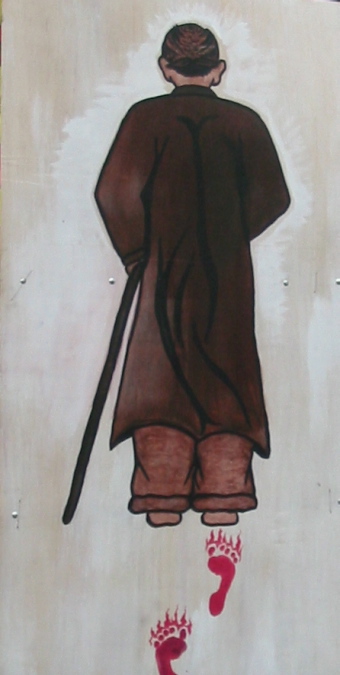Matthew Woolgar
Between midnight and 4am on 15 November 2009 approximately 2000 people took part in ‘Yogya Wall Nation’, a mural competition held in the centre of Yogyakarta. The participants produced around 500 murals for the competition which were then displayed for several weeks along the length of Jalan Malioboro, a famous shopping stretch in central Yogyakarta.
The theme of the mural display was 'The Spirit of Sudirman' - Sudirman being the first Commander in Chief of the Indonesian armed forces. He is also officially recognised in Indonesia as a national hero for his role in the revolutionary struggle against the Dutch.
One competition, many motivations
The competition was organised with the involvement of local army units and the Yogyakarta city government. Registration took place in army posts and the army also provided logistical support, for example installing the completed murals on bamboo frames along Jalan Malioboro. Indeed, the idea for the competition emerged during inspections of student accommodation by the army and police forces as part of an anti-terrorism exercise.
Lieutenant Colonel Arudji Anwar explained that most student rooms were ‘without posters of the Indonesian heroes who founded the nation’. He saw, however, ‘lots of posters of people from foreign countries’, which deeply concerned him. This led to the idea of a mural contest as a means to raise consciousness of, and pride in, Indonesian national heroes.
If for the army the competition offered the opportunity to promote its national heroes, for the city government the competition supported their efforts to develop Yogyakarta as a centre for culture and tourism. In particular, the competition provided the chance to help develop Yogyakarta's reputation as a 'city of murals'. This is part of a wider effort that has seen the local authorities commission street art around the city, for example, to mark Yogyakarta’s Biennial celebrations.
Although the competition was aimed at young people, it drew participants from diverse backgrounds. Competitors ranged from tattooed punks to policemen and came from as far away as Bali and Sumatra. They were partly drawn by the attraction of cash prizes for the winning murals, with a total of Rp.21,000,000 (A$2500) to be divided between six prize-winning murals. More importantly however, the competition offered them the chance to express their own interpretation of Indonesia’s past.
One spirit, many interpretations
The theme of the event gave competitors wide scope to re-interpret the life of Sudirman and the Indonesian national struggle. The organisers judged the images against values they took to represent the 'Spirit of Sudirman': a refusal to give up, simplicity or modesty and a willingness to make sacrifices for the nation.
In practice, however, participants used the contest’s theme as a stimulus to tackle a range of concerns about present Indonesian politics together with its society and culture. Murals dealt with issues in the news at that time or with local significance, as well as exploring the themes of national and cultural identity.
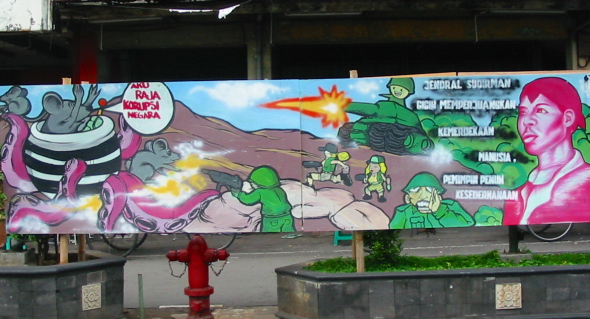 |
Corruption was a theme of a number of murals. This issue had particular potency because the contest took place not long after evidence had emerged implicating the police and public prosecutors in a conspiracy to frame two leaders of the Corruption Eradication Commission, which sparked demonstrations across the country. In the above mural the simplicity of Sudirman's life is contrasted with the greed of corrupt officials. The text on the right reads 'General Sudirman persevered in struggling for independence, a modest man and leader.' The lead rat is saying 'I'm the king of state corruption.'
 |
Education was another prominent theme, given its special importance for Yogyakarta, which is known as a centre of learning and is home to a large number of institutions of higher education, including the prestigious Gadjah Mada University.
 |
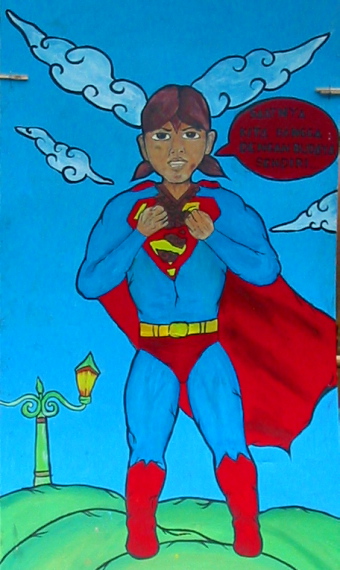 |
Some of the complexities of the influence of western culture were evident in the use of the figure Superman. The first image shows Sudirman, on the left, facing Superman as an equal. Sudirman is wearing a blangkon, a type of Javanese headdress. Behind him are bamboo spears, weapons that are particularly associated in Indonesia with the struggle for independence. The caption reads 'A great and mature nation is a nation that values its heroes.' In the second, Sudirman, again wearing a blangkon, tears back his Superman suit to reveal a batik-style design. The caption reads 'It’s time we were proud of our own culture.'
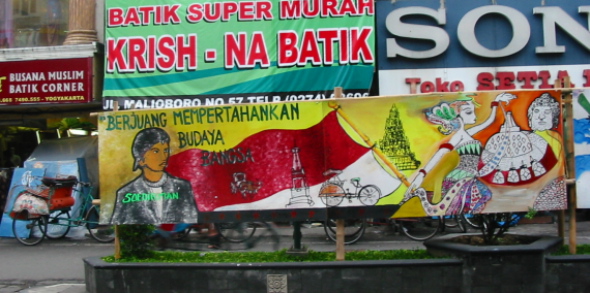 |
Insecurity about Indonesian cultural identity was apparent in several images. The caption in the above image reads: 'Struggling to defend Indonesian culture’. The inclusion of a dancing woman is particularly significant. Earlier in 2009 a widely publicised dispute erupted over the use of the Balinese Pendet dance in Malaysian tourism adverts. Many Indonesians felt this was a case of Malaysia trying to 'steal' Indonesian culture. Other symbols of Indonesian cultural identity are visible in the background: on the left is a becak and at the top of the image are two signs for shops selling batik.
 |
Several murals, including this one, had captions in Javanese, demonstrating the enduring significance of a distinctly Javanese culture in Yogyakarta. The caption of the above image encourages people to act themselves in defence of the culture rather than leaving the work to others.
 |
Others, such as the one above, interpreted the spirit of Sudirman as a journey striving towards a bright future for the nation. However, there was also a note of uncertainty about what that future would entail. The mural below highlights this uncertainty. The caption asks where Indonesia is, or should be, heading.
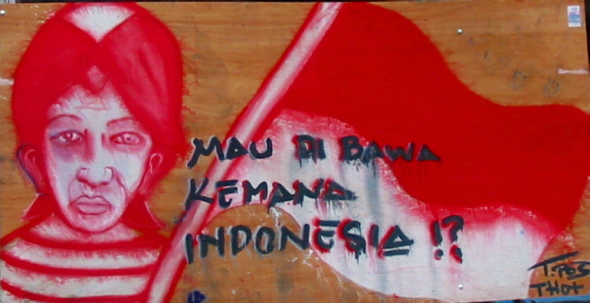 |
Yogya Wall Nation was a great success, attracting more participants than were expected and bringing together people from diverse backgrounds. The organisers were so impressed that they extended the length of time the murals were displayed and there are plans to make the competition an annual event. Contestants became involved for various reasons but the contest acted as a focus to bring these disparate groups together.
A key attraction for the artists was the opportunity to freely express their particular view on the importance of the ‘spirit of Sudirman’. The result was that the competition's theme acted as a starting point to make varied statements about a whole range of pressing issues, showing how vibrantly Indonesia's past and present are being contested in post-reformasi Indonesia.
Matthew Woolgar (matthew.woolgar@history.ox.ac.uk) graduated in History from the University of Oxford. He is currently in Yogyakarta studying Indonesian language.
Inside Indonesia 101: Jul-Sep 2010
